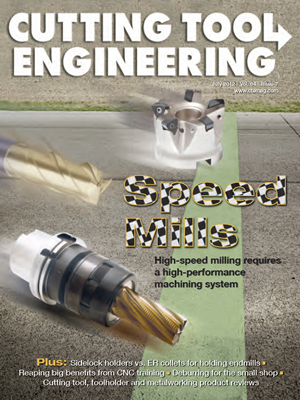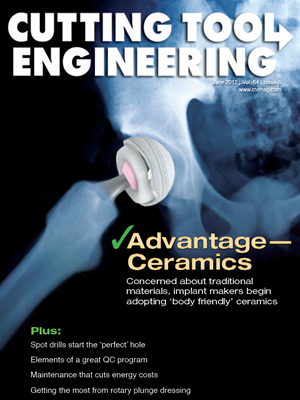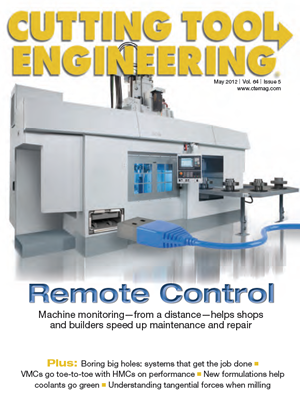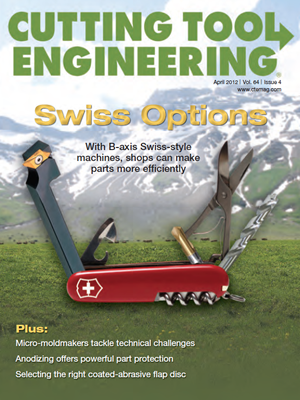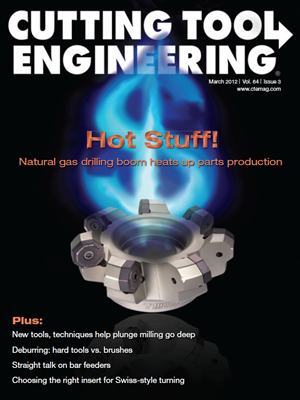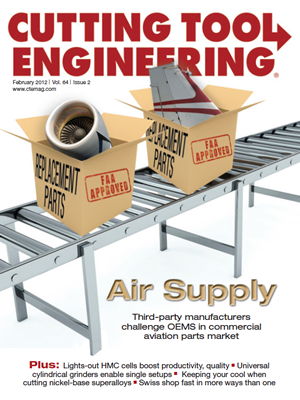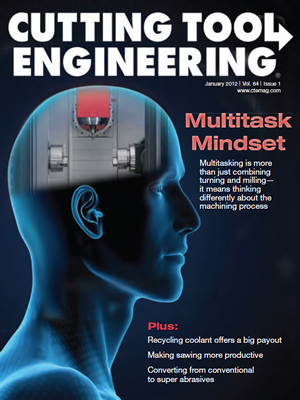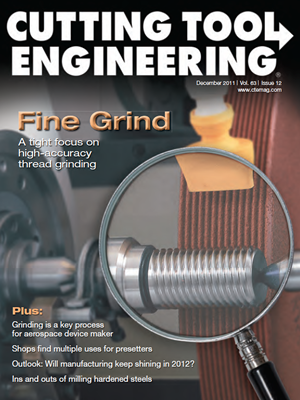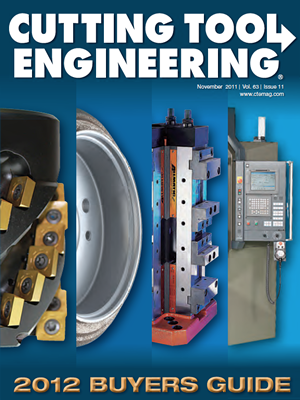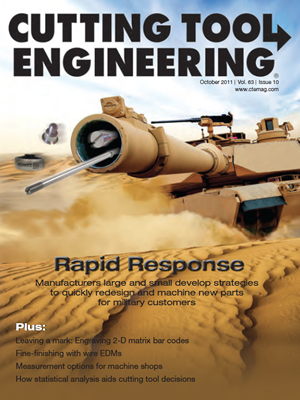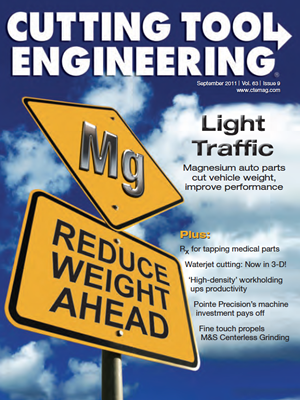August 2012 | Vol. 64 | Issue 8
CTE’s 2012 Salary Survey reveals how much various metalworking professionals are making, and the results are mixed. PLUS:
- Retrofitting is an effective and economical option to make new money with old machine tools
- Groove milling can effectively perform slotting and slitting
- Vending machines can help manage tool and supply usage and keep costs in check
- Minnesota shop succeeds by being good at many different part-grinding methods
- CTE Web site grows traffic, expands video, product and machine shop content.
July 2012 | Vol. 64 | Issue 7
Users reap the rewards of high-speed milling when elements of the machining system complement each other. PLUS:
- A sidelock holder or an ER collet can be the best choice for holding endmills
- Benefits abound when workers and students are exposed to machine and CNC training
- Deburring recommendations for small machine shops with tight tolerances.
June 2012 | Vol. 64 | Issue 6
The market for ceramic medical implants continues to grow along with the demands for making them. PLUS:
- Spot drills are essential when making ‘perfect’ holes
- The top 10 issues for maintaining and enhancing QC in parts manufacturing
- Managing energy costs and improving energy performance requires an ongoing commitment
- Understanding and controlling wheel truing and dressing forces when rotary plunge dressing.
May 2012 | Vol. 64 | Issue 5
Remotely monitoring machine tools quickens maintenance and repair. PLUS:
- There is a boring system to get the job done, regardless of hole size
- How do VMCs stack up against HMCs
- Maintaining machine performance with ‘green’ coolant chemistries
- Understanding tangential cutting force when milling
- Learn details about the many new products manufacturers are offering the metalworking industry.
April 2012 | Vol. 64 | Issue 4
A programmable B-axis on a Swiss-style machine gives part manufacturers a better angle for doing complex work. PLUS:
- Sizing up the state-of-the-art of micro-moldmaking
- Anodizing parts offers numerous benefits, including wear and corrosion resistance
- When choosing among coated-abrasive flap discs to remove metal and finish parts, grit size is just the beginning.
March 2012 | Vol. 64 | Issue 3
Making parts for hydraulic fracturing drilling operations is a big opportunity for shops but requires the right tools. PLUS:
- Benefits of plunge, or Z-axis, milling
- Considerations when choosing a hard tool or brush to deburr holes
- Bar feeders enable high-speed, automated operation, but choosing the right one depends on your part volume and budget
- Dynomax Inc., an unusually diversified manufacturer, is investing in equipment and employees to target new markets
- The right insert for Swiss-style machining of microparts is often one with a near-zero radius.
February 2012 | Vol. 64 | Issue 2
Producing commercial aircraft replacement parts requires unwavering commitment. PLUS:
- Improving productivity and quality with unattended horizontal machining cells
- Multiple-operation cylindrical grinding machines complete parts in a single setup
- With the right approach, machinists can eff ectively cut nickel-base and other high-temperature superalloys
- Swiss Automation’s success is based on machining complex parts quickly, accurately and consistently.
January 2012 | Vol. 64 | Issue 1
Strategic approaches maximize utilization when multitask machining. PLUS:
- Recycling coolant pays big dividends for job shops
- Knowledge of the different facets of sawing can make the process more productive
- A guide to converting from conventional abrasives to superabrasives when double-disc grinding
- Bridging the gap between academic and shop-fl oor grinding knowledge.
December 2011 | Vol. 63 | Issue 12
When accuracy counts, thread grinding shines. PLUS:
- Triumph Actuation Systems makes systems that keep aircraft flying straight
- Shops find many uses for presetters
- Manufacturing was a star in 2011 and looks to shine brightly in 2012
- Requirements for milling hardened steels.
November 2011 | Vol. 63 | Issue 11
2012 Buyers Guide issue:
- Manufacturers index
- Disributors index
- Machne Shop index.
October 2011 | Vol. 63 | Issue 10
Manufacturers large and small develop strategies to quickly redesign and machine new parts for military customers. PLUS:
- Tools and techniques for engraving 2-D data matrix bar codes on machined metal parts
- Fine finishing with wire EDM is eliminating the need for secondary operations
- How microscopes and vision systems are used in machine shops for noncontact inspection and measurement
- Statistical analysis of metalcutting data can help shops select the right indexable insert geometry.
September 2011 | Vol. 63 | Issue 9
‘Lightweighting’ vehicles through the use of magnesium parts can improve vehicle mileage and impact resistance, among other benefits. PLUS:
- Tapping medical parts requires unique considerations not needed in general-purpose tapping
- Special glasses are not required, but multiple other considerations apply in 3-D abrasive waterjet machining
- High-density workholding squeezes more productivity from machining centers
- Wisconsin-based Pointe Precision creates business opportunities with new machines and skilled employees
- With technology, experience and attitude, M&S Centerless Grinding is breeding grinding success—on a very small scale.




